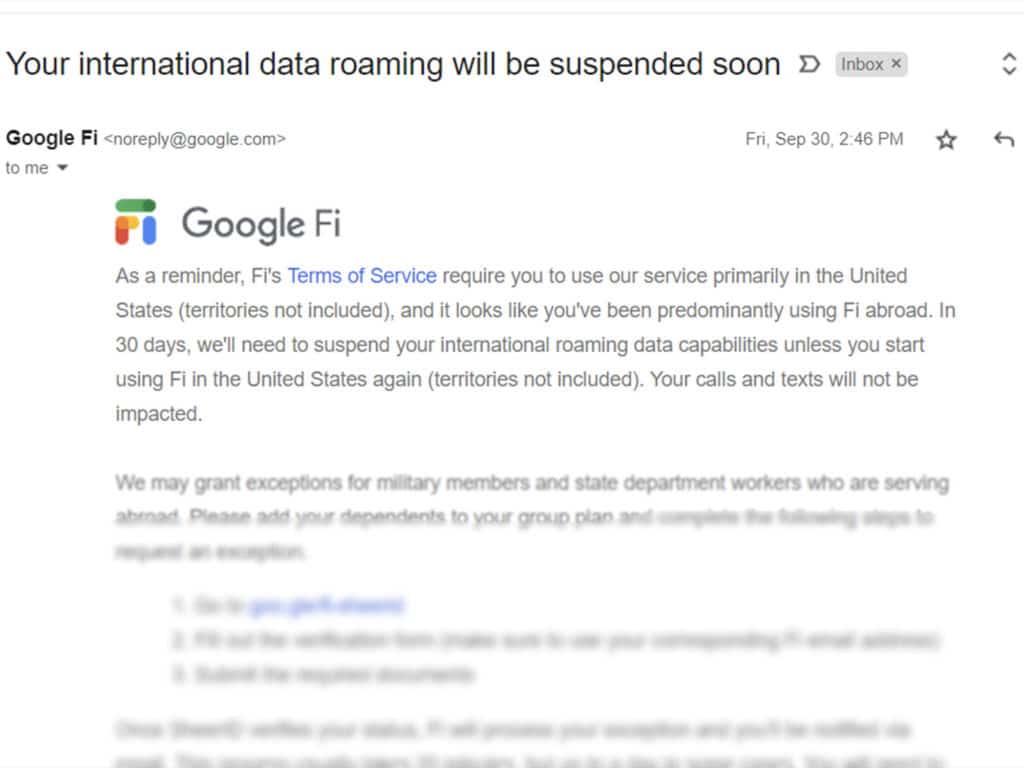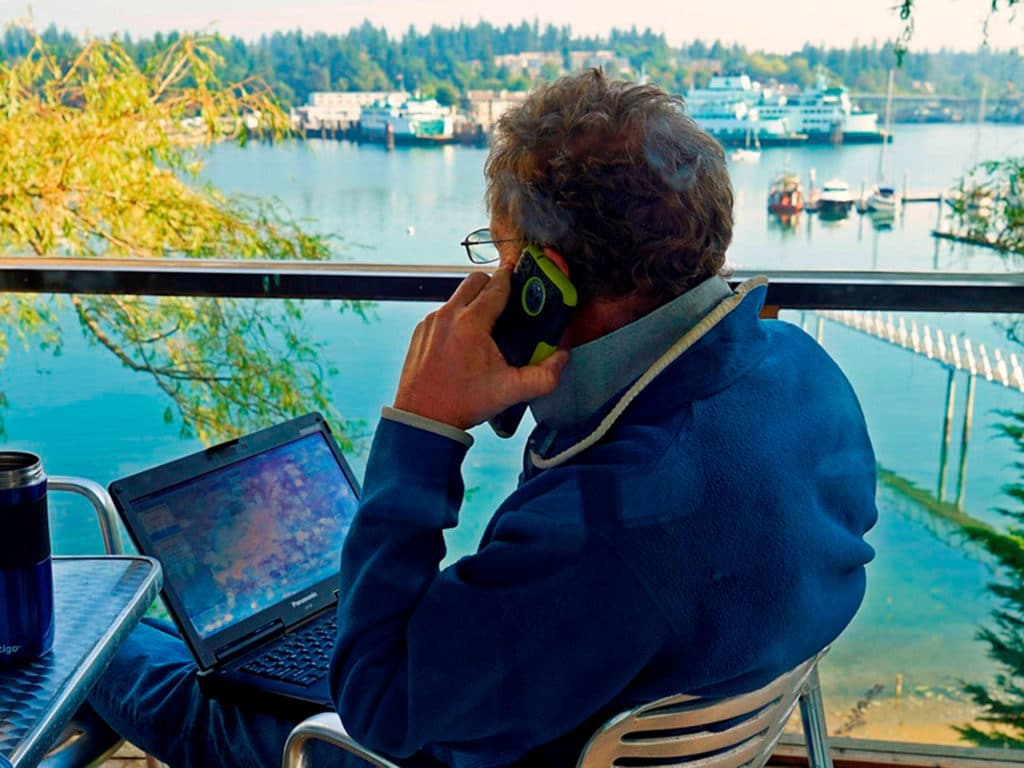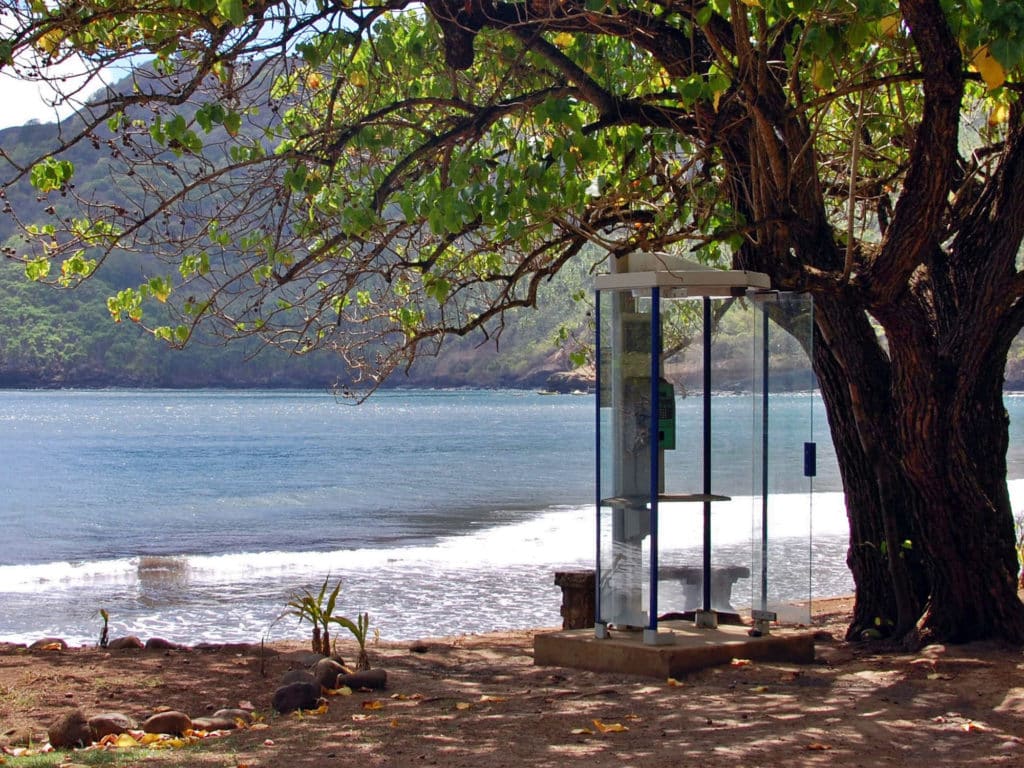
Last month, we received the service termination message that every long-term cruiser dreads. After more than four and a half years, Google Fi had cottoned on to our expat status. As with every other US cellular service carrier we are aware of, the fine print requires phone use to be predominantly in the United States. We were being cut off.

This development has forced us to take a fresh look at service options for phones while traveling full time. Here’s a roundup of options for using your phone while cruising.
Local Phone Service While Cruising
Most full-time travelers get a SIM card from the country they are in and use it for calls, texts and data. This is usually a straightforward process (just make sure your phone is unlocked).
We’ve gotten SIMs in dozens of countries now. The SIM itself is usually just a few dollars. Service is prepaid for a period of time, and some quantity of data is included. That data has almost always been (much) cheaper than Google Fi, too. Hotspot your phone, and other devices connect for internet access.
The downsides? You’re not immediately online in a new country, and some folks at home may struggle to keep up with your changing number or international dialing.
Changing Phone Numbers
Getting a new SIM means a new phone number and a new data plan. For many cruisers, that’s no big deal. If you’re accustomed to using texting apps instead of exact numbers, remembering someone’s number isn’t critical.
But for friends and family at home, it might be a big deal. Here are a few options to try before going the more complicated route of retaining your phone number.

To make it easier to receive or make phone calls, two especially useful apps are WhatsApp and Skype. They have different benefits, and it’s useful to have accounts for both.
WhatsApp is overwhelmingly how we connect with everyone from taxi drivers to the veterinarian to our cruiser neighbors in the shipyard. It also facilitates group communication. The shipyard here in Puerto Penasco, Mexico, has a WhatsApp group for general communication, as well as groups specifically for bartering and swapping boat parts, or coordinating the truck delivering fresh water.
Skype is also valuable because you can “dial” out to US or other phone numbers using it (WhatsApp is just between accounts). This is usually easier than dialing out from your international SIM du jour, especially if you want to dial a toll-free number, which is not possible from many international SIMs. To make calls like this requires a paid account, but the cost is reasonable: a couple of cents per minute. We put $10 in as a starting balance and top it up automatically; our US number shows up on caller ID from Skype, too.
Your bank may want to send your account verification by text. This does not work with an international number. It also doesn’t work with a service like WhatsApp or Skype. What can you do?
First, try avoiding call or text authentication. Tell your bank that you don’t have an available mobile number, and need to do verification via email instead. Or, look into VOIP (Voice Over Internet Protocol) phone services, which provide a US or Canadian number. These include Google Voice, Tossable Digits, Line2 and OpenPhone. Cruising friends use a free number from TextNow for all their texting and two-factor authentication. Some are free, while some include a nominal fee.

The gotcha with VOIP? Some banks won’t use a VOIP number for authentication. If a Google Voice number is tied to your Gmail account, it’s possible can get locked out of the account.
If You Want to Keep Your Phone Number
The easiest, albeit most expensive option is to retain your existing service and pay roaming fees. The ultimate cost? Losing your service, and maybe your number. Cruising friends with AT&T and T-Mobile each experienced this, despite extenuating pandemic circumstances.
The middle-of-the-road option: We could have kept our service with Google Fi, but without any international data (it takes 90 days in the United States to reset). That would cost about $30 a month just to retain a phone number.
The lowest-cost option is to port (transfer) your current phone number to a VOIP service that offers international call forwarding. Fees vary: we pay about $5 a month. Then, you can update the VOIP forwarding number with each new SIM you purchase. Friends and family call your home number, and it rings on your current phone.
If You Want to be Instantly Online
Getting instantly online was the promise of Google Fi. I’m going to mourn it. There are options, but none with the mix of simplicity and relative value.
You can keep your existing plan, but usually, the cost is exorbitant or you’ll get cut off based on international usage. You also can get an eSIM. It hops countries, but with about the highest data cost you can pay (except roaming fees with your home carrier). Services include OneSimCard and TravelSim.

You also can get a SIM in advance. This is harder when country-hopping, but easy for getting started. MrSIMCard will mail an activated Bahamian SIM to a US address.
Or, you can forgo being instantly online. Stick with your offshore comms for those few hours to wait until you can suss out a new SIM card on shore.
Our Strategy for Phones
Keeping our number was important, but paying $30 a month for zero data was a bad deal. So, we’ve ditched Google Fi and ported our US cell number to Tossable Digits. Its fee varies by country; Mexico is $5 a month, and my Mexican plan is $10 a month.
The service forwards to my Mexican SIM. Calls to our US number ring through; text notifications ping, too. It’s seamless connectivity, in terms of being accessible and keeping our phone number.
I’m also playing with a TextNow number. If direct dialing to our “normal” US number wasn’t important, this would an inexpensive (about $5 per year) way to manage.
No conversation about comms is complete without touching on Starlink. Check back soon for our current take on adding Dishy McFlatface to a cruising sailboat.
Do you have a favorite VOIP service or comms app that belongs here? Please let us know at editor@cruisingworld.com, or in the comments.








